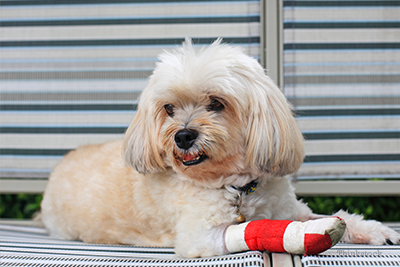
Kelly Serfas, a Certified Veterinary Technician in Bethlehem, PA, contributed to this article.
Bandages are used for various reasons. They can absorb drainage, protect incisions and help with cleaning up wounds. A bandage that contains a hard, molded piece of plastic is called a splint, which can provide immobilization before and after a fracture is repaired. Your veterinarian should always put the bandage on, but once you get home it’s important that you keep a close eye on it.
Make sure the bandage isn’t too tight
If bandages are too tightly wrapped, they can cause excessive pressure and cut off blood circulation. A simple way to monitor this is to check your pet’s toes several times a day. The middle toes (3 and 4) and the toe nails normally touch each other. Toes that become swollen don’t touch each other, which means that the bandage it too tight. If you’re not sure what normal toes should look like, simply look at the opposite foot to compare.
Make sure the bandage doesn’t get wet
If the bandage gets wet (from drinking water, urine, dew or rain), it means the materials used to wrap it may constrict the leg and cause the same problems mentioned above. In addition, a wet bandage can lead to skin infection because dark, moist and warm areas are breeding grounds for bacteria. Infected areas tend to have a nasty odor, so you may want to "take a whiff" on a daily basis to ensure that the skin is happy under the bandage.
Prevent the bandage from becoming wet or soiled by covering it when your dog goes outside. Your vet can provide you with a special cover or you can make one with a simple plastic bag or "press and seal" type material. Remove the cover as soon as your pet is back inside. The bandage must be able to "breathe" in order to prevent moisture from building up inside of the bag. This would cause the bandage to get wet anyway.
Make sure the bandage doesn’t get chewed
Your dog must not be able to chew or lick at the bandage. A device such as an E. collar (plastic cone) will prevent him from destroying the bandage. Even when pets seem to be uninterested, they can chew up the bandage when they get bored or start feeling itchy or painful. They can cause a lot of damage in a very short period of time, possibly returning the healing process to square one. Swallowing parts of the bandage could cause a blockage in the intestine!
More bandage tips
- Even the best of bandages can slip, and therefore become useless. Very energetic dogs and dogs with shorter and stockier legs tend to be very difficult to bandage.
- If you note any of the problems mentioned above, do not hesitate to call your vet and ask to be seen. If it’s after hours, please take your dog to the closest emergency clinic. Needless to say, bandage changes should be performed by a veterinary professional.
- Even if everything goes well, the bandage should be scheduled for changing regularly. This should be done from once a day to once a week, depending on the reason for the bandage. However, if any of the signs above are noticed at home, it may need to be changed sooner.
- Using a pet bandage is as much of an art as it is a science. You play a big role in taking care of it appropriately at home.
Questions to ask your veterinarian
- When should I come back to have it changed?
- How do I take care of the bandage at home?
- When should I have the bandage removed?
If you have any questions or concerns, you should always visit or call your veterinarian -- they are your best resource to ensure the health and well-being of your pets.




